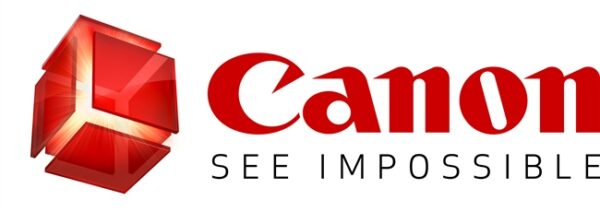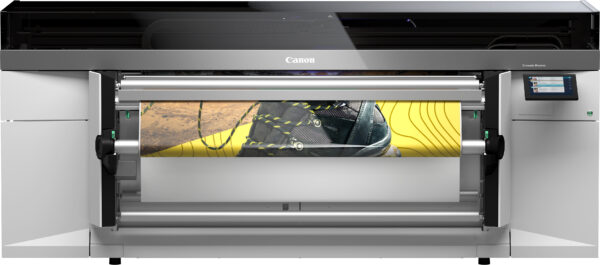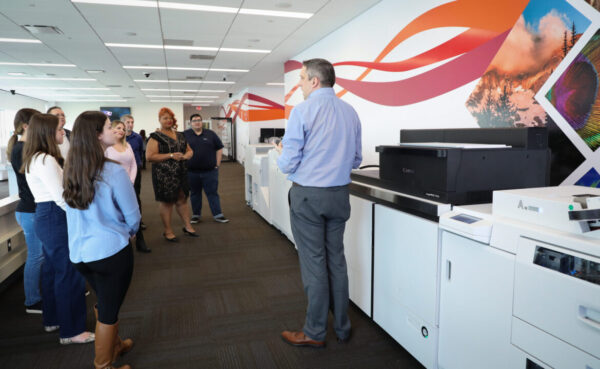Focusing on customer applications rather than volume is a stepping stone to more production print opportunities.
“Volume is not the best metric when it comes to production printing,” said Bob Barbera, director, production solutions marketing and a G7 expert at Canon U.S.A. “It used to be a good measure, but today it is more about the range of applications being run.”
Barbera points to the number of jobs printed in offices that, not so long ago, would have gone to a local quick print business or commercial printer. The tally is not necessarily good news for some small print shops but can be a bonus for businesses that step up to machines with higher recommended print volumes and greater capabilities. Your dealership can have part of the light production (machines with speeds generally between 75 to 120 pages per minute) action.
The Trickle-Down Effect
Driving this trend is technology that began at the top end of the digital printing market. The best image quality was once the province of machines that were far beyond the reach (and checkbooks) of any but busy commercial printers. While few of these devices have become more affordable, their paper handling, speed, imaging technologies, finishing, and even workflow software has trickled down to many moderately priced machines available from dealers. These are being snapped up by businesses that appreciate the value that comes with producing top-quality documents internally instead of relying on outside providers. At the same time, savvy dealers have upped their games to go beyond basic printing by adding value with superior color, high print quality, and inline finishing options. Together, forward-looking dealers and their customers are changing the landscape of what was once thought of, sometimes derisively, as office printing.
“Key drivers are image quality, versatility and reliability,” noted Barbera.
This troika was once unobtainable on most smaller printers, but that is no longer the case.
While not all machines in the different speed categories have these features in spades, it does not imply that smaller, lower priced, or less capable machines are less reliable than their larger counterparts. It’s more that a step or two up the product line typically adds greater capacities and more all-around performance, partly due to the ability to add a wider range of finishing equipment and the integration of sophisticated workflow software.
One place taking advantage of these capabilities is Repco Solutions in St. Louis, Missouri. Its dealer is GFI Digital, a multilocation Ricoh and Sharp dealer led by Bruce Gibbs, who has taken advantage of a market need for higher volumes and more applications. GFI Digital supports many smaller businesses, as well as Repco Solutions, where owner Fritz Zaegel has transitioned from a commercial printer to a marketing services company. Repco has a mix of offset presses, as well as two Ricoh Pro C9210 color printers supported by GFI. Volume on the Ricoh boxes runs up to 200,000 pages a month.
“It used to be quality, speed, and price, pick any two,” recounted Zaegel, noting that he had always been able to deliver top-level quality on his offset presses. “Now we can quickly deliver all three on the digital devices at a very competitive price point.”
Then there’s added flexibility. Depending on customer needs, Zaegel’s team will provide a shorter run, perhaps a few thousand for immediate use on one of the C9100 printers, followed by a longer run on his offset presses.
Zaegel’s use of the Pro C9210 printers is an indicator of the opportunity in quick print or small commercial print operations that is available to dealers seeking to serve a broader range of businesses. Gibbs said it requires a commitment on the part of a dealer to service such accounts, but it has also set his dealership apart from the competition. Service is a key element for fast-paced production operations and Gibbs makes a point of making sure customers like Repco are properly supported.
“We know Repco will run second shifts and even be running six or seven days a week,” explained Gibbs. “They can’t be down. We make sure their key operators always have a direct line to one of our service techs so they will have the support they need. Repco keeps some common parts on hand, and we have other parts available so we can minimize any down time.”
GFI also goes a big step further in having two complete, new Ricoh C9210 printers on hand that can be used as parts sources in the unlikely event a needed part is not available. Any parts removed from one of these machines are replaced immediately, and having the extra machines means even rarely needed parts are readily available.
“Servicing higher volume businesses requires a different level of commitment than you have servicing offices that run 9 to 5, five days a week,” said Gibbs. “It includes additional training for our service techs, but it also deepens the relationship with customers like Repco.”
Zaegel agreed, “Because GFI is local we really get to know the people there. It becomes a partnership because we know and trust each other.”
Be More, Do More
Reaching this point though, means doing much more than providing equipment.
“Dealers need to have the back-office structure to support the platforms they’re selling, beyond break-fix and into the territory of being a true ally,” said Brian Balow, vice president, dealer division, integrated production solutions at Ricoh.
Acting in this capacity means understanding and being able to implement the best practices. This by no means limits the playing field to only big dealers, but you need to know your strengths, weaknesses, and build upon and around them, especially when growing your strength in the production segment.
Most equipment vendors can help dealers do this, and most are eager to help. So, when you see opportunity never assume a bigger prospect is out of reach. Gather the intel you need and work with your OEM to find ways to do and be more. They want to help and know that dealers are one of the ideal entrées to a broader market. This is an area where dealers can be especially well-positioned to shine, because some vendors have made helping dealers build their capabilities an area of focus.
Canon’s Barbera concurred, “Canon dealers need to be certified to sell and service the higher volume equipment, but the company has a guide to help smaller dealers scale up and go after bigger accounts.”
The message here is that the is business out there for those who are willing to go after it. After all, what can be wrong about expanding your business with higher volume machines that support a broader range of customers?
Expertise Matters
It used to be that as long as your tech guys had a good car stock, were there for break-fix, and could drop off paper and toner, things were pretty much OK. Then, somewhere along the line—about when color became expected rather than nice to have—copying and printing became a bit more complicated. Sure, black and white was still the go-to in many places, but in schools, religious organizations, and more, being able to print in color was a great leap forward. To be sure, not everyone is able to print in color all the time, but when a job has to be in color, there can’t be any excuses. But there’s more to printing color documents than sending the file to a printer or pressing a big green button.
“The number one key to a dealer’s success in light production is having a specialist on staff,” noted Kent Villarreal, senior product manager for product planning and marketing at Sharp Imaging and Information Company of America. “This expertise is where you’ll see the biggest impact in terms of delivering on customer expectations.”
According to Villarreal, the specialist is the trainer and onsite expert who can teach the sales team the lingo—how to talk with the customer or prospect—and help set expectations.
“The specialist understands what questions to ask and where to look for opportunities,” said Villarreal. “And once a sales rep brings in those opportunities, the specialist can do the demo and get deeper into the [customer’s] workflow, find the pain points and help close the business.”
At Sharp, part of this is a customer expectation document that dealers and Sharp’s direct sales reps use to set expectations for products. This helps prevent situations such as having customers push machines outside the specifications in the device and resulting unnecessary service calls. Such calls are the bane of any dealer. No matter where a machine is placed in a company, it is all but assured that someone will push the device’s limits. The temptation to do so can be even greater for machines with higher duty cycles, so it is more important to make sure customers know the limits. Making customers smarter always pays off.
The Inkjet Option
Any dealer who has placed copiers and printers in legal or consulting firms knows to expect that customers will push the limits of monthly duty cycles on a regular basis. Some (even many) customers are willing to pay additional service costs as they press lower duty machines into production environments. But they are often beginning to realize they see the service tech a little too often, and a machine is down too often, especially when they tally up invoices for service calls that exceed the scope of the original contract. Addressing this challenge, OEMs, with the encouragement of dealers, have brought increasingly more robust machines to market that benefit from technology that has trickled down from larger devices.
As technology evolves, what gets interesting is that some smaller machines are finding homes where their capacity can make them a good fit alongside machines capable of hundreds of thousands of impressions per month. Bill Nichols, for example, runs Bluegrass Integrated Communications in Lexington, Kentucky. The bulk of the bills, statements, direct mail, and fundraising materials produced stream off a SuperWeb press, a machine that looks a bit like offset commercial presses but uses inkjet heads from Memjet. That press is a great fit for many of Nichols’s customers, but some jobs require a different approach. Small to mid-size toner machines—once the go-to for such applications— were not a cost-effective solution. Since he liked the economics of the big SuperWeb inkjet press, Nichols wondered if there was a smaller inkjet solution that made sense.
“We have three Riso inkjet machines now,” said Nichols. “They have multiple drawers so we can run postcards and envelopes, and they work well for pre-printed shells.”
These are all mainstay needs for the companies that need to do more than letter- or legal-size documents on a regular basis.
Bluegrass Integrated Communications does up to 4 million impressions per month across the three machines. Some of this includes reprints of work done on the SuperWeb press because it’s not practical to run a single bank statement or utility bill that has been damaged in production. But it’s trivial to run a single set of pages on a small inkjet device.
“Production printing is a big growth opportunity for a dealer,” said Maggie Curry, senior manager for production printing systems at Riso. “It represents a new revenue stream, and inkjet lets dealers be very competitive against toner devices at the production level.”
As Canon’s Barbera noted, production has changed, providing new opportunities for dealers. Talk with your OEMs about how you can support a broader range of customers and look for opportunities at companies you may have dismissed before. The technology and support you need is available and there may be money on the table that you aren’t seeing.
Access Related Content
Visit the www.thecannatareport.com. To become a subscriber, visit www.thecannatareport.com/register or contact cjcannata@cannatareport.com directly. Bulk subscription rates are also available.




